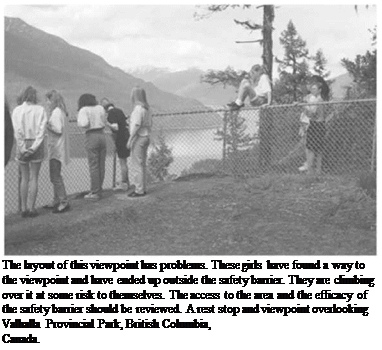Handrails serve two functions: as aids to negotiating difficult sections of the trail, such as steep pitches or steps, and as safety barriers to prevent people from falling. Along most paths, handrails should be unnecessary, but they are needed where steps are steep, where boardwalks or bridges are raised more than 500 mm (18 in.) above the surface of the ground, and where the path passes near a dangerous drop or cliff edge and over water. Handrails must be strong enough to support the weight of a person pulling or leaning on them as an aid to climbing, and to withstand the sideways movement of someone leaning or falling against them. Where small children
use the trail, lower-level railings or an infill panel are also required to prevent them from slipping beneath the top rail.

Handrails can be constructed from different materials and in a variety of ways. The simplest are aids to using steep stretches of trails and ledges on the most mountainous paths. These can include knotted ropes anchored to the rock with eyelets, steel cables held similarly, or galvanized steel handrails bolted to the rock. These are positioned on the inside of the and are not intended to prevent people from falling from the trail.
Handrails for support and safety must be sited along the outside edge of the path. Sturdy timber railings attached to wooden posts spaced at 1 m (3 ft) intervals are ideal in most circumstances. A substantial top rail looks good outdoors and gives structural strength, but it might also need a smoother, narrower handrail fixed proud on the inside, for people to hold
onto. Beneath the top rail narrower railings spaced horizontally prevent children from slipping through. An alternative to wooden lower rails is taut wire cables. These look lighter from a distance, and allow small children and people in wheelchairs to see through the barrier to the views beyond. In more urban settings wooden walls made of vertical boards fixed to rails mounted on posts can be used. These are less easy to climb than barriers made from horizontal rails.
Wire mesh barriers on steel supports might seem stronger, but they look out of place in most wild landscapes. They are cheaper to maintain if galvanized.
Stone walls (cemented for safety) might be appropriate in more developed settings, perhaps at view-points and in mountainous areas where stone is the dominant material. The top of the wall should incorporate features such as pointed capstones to prevent daredevils from climbing on it. Panels of railings or tensioned wires can be inserted into the wall to enable viewing by smaller children or people in wheelchairs, who are unable to see over the top.



